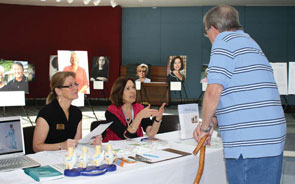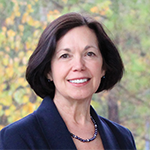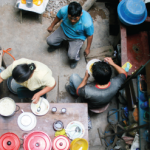
While growing up, researcher Leigh Callahan, PhD, had no specific blueprint for a future career, but her love for math as a youngster eventually drew her to a profession that suits her well.
To her knowledge, when she was a child, there were no epidemiologists living in her hometown of Rutherfordton, N.C. She jokes that the town was so small, there were probably more letters in its name than people living there.
Lured by the field of medicine but with no desire to become a physician, Dr. Callahan has devoted more than two decades to studying health disparities in relation to personal and family income. She is not keen on needles, but data and numbers are a different story.
“I like thinking about medicine and health outcomes, and I always, as a child, liked math and statistics, so I think epidemiology is sort of really a perfect fit for me,” she says.
Dr. Callahan obtained a bachelors degree in radiologic science from the University of North Carolina (UNC), Chapel Hill, and a PhD in public policy from Vanderbilt University in Nashville. Her long-time interest in arthritis began with her first research endeavor as a graduate student at Vanderbilt when she collaborated withTheodore Pincus, MD, to develop and refine ways to measure feelings of helplessness among people with the disease.
“I started years ago in a retrospective follow-up study in rheumatoid arthritis where we saw that education made a difference in predicting mortality,” says Dr. Callahan.
That study was the starting point for Dr. Callahan, who wrote her PhD dissertation on evaluating the construct of learned helplessness. She later investigated links between income disparities and how, in particular, where you live can make a difference in your overall health.
“My interest has been the role of individuals in their own health outcomes,” says Dr. Callahan, who notes that people who are poor and battling arthritis are far less likely to triumph over a debilitating disease.
“I’m looking at socioeconomic status, so looking at an individual’s education level, their occupation, their income, and how that affects their health outcomes,” such as disease prevalence and mortality.
Research indicates that most common chronic diseases are more prevalent and have a higher morbidity and increased mortality in individuals with lower levels of socioeconomic status, says Dr. Callahan.
Diverse Accomplishments
Before taking on her present position as a professor of medicine and social medicine and director of Multidisciplinary Clinical Research at UNC Thurston Arthritis Research Center, Dr. Callahan worked at the Centers for Disease Control and Prevention (CDC) as the first full-time epidemiologist in the arthritis program. During her three-year stint at the CDC, she cultivated cooperation between government and the Arthritis Foundation.
Dr. Callahan currently mentors graduate students on research projects and serves on dissertation committees at UNC. She is a member and past president of the ARHP and has written numerous published articles and frequently speaks at conferences about her findings.
Linda Ehrlich-Jones, PhD, RN, a clinical research scientist at the Rehabilitation Institute of Chicago and immediate past president of ARHP, describes Dr. Callahan as a fantastic researcher who is personable and always willing to help. “She appears to be laid-back, but she is obviously very productive and works very hard at what she does,” says Dr. Ehrlich-Jones. “She is very kind, helpful, and giving.”
Fun for Dr. Callahan is watching her favorite basketball team, the UNC Tar Heels, and conducting research. She strives to demonstrate to students that research is “a lot of fun” as well as a worthy pursuit.
“I think it appeals to my sense of justice. I think we need to be, as a society, thinking about how we can have the best possible health outcomes for everybody,” says Dr. Callahan.
She says her interest in health disparities has snowballed over the years as the situation in the United States worsened, especially when compared with other countries. “There’s a lot of evidence that, the wider the gap between the rich and the poor, the worse the health of the whole nation is,” she says.
Very often, people with a low economic status also have minimal health literacy; their level of education mirrors how well they can obtain and understand information about their health. Obviously it’s not possible, says Dr. Callahan, to send everyone back to high school to get a degree, but research can serve as a catalyst to change public policy so that better health interventions are adopted.
Health Outcomes and Where One Lives
Over the years, Dr. Callahan has expanded her research to look at other indicators of socioeconomic status and how they interplay with health outcomes. In a paper published recently in Arthritis Care & Research, she looked at education, home ownership, income, and occupation, all of which can predict disease outcome, she says.1 Her research showed that individuals who had a household annual income less than $45,000 had poorer health status than those who had an income greater than $45,000. However, a good education and income does not assure good health if you are surrounded by poverty, says Dr. Callahan. “We also find that where we live makes a difference,” she notes.
From a public health perspective, I really like the idea of thinking about … interventions that are outside the medical system that people can do that will make a difference in the outcomes of their arthritis.
Research shows that if you live where a large number of people are living below the poverty line, even if you have a high level of education, you will have a worse outcome, says Dr. Callahan.
Access to medical care is another important factor to maintaining health, as is teaching people what they can personally do to control their disease, notes Dr. Callahan. Her research showed that intervention with self-management programs can help people battling arthritis to reduce feelings of helplessness and lack of control. People feel empowered once they learn that being more physically active can reduce fatigue and stiffness.
Courses based on social cognitive theory can greatly impact how a person deals with disease. Add to that concept the tools that teach specific disease management techniques, and good results increase greatly, says Dr. Callahan.
“Say someone wanted to start to be a little more physically active … but they felt overwhelmed about going to a class, didn’t want to put on spandex, or they didn’t have the money to join the gym,” Dr. Callahan gives as an example. “Well, in an arthritis self-management course, they teach people the tools to say ‘Ok, so you want to become physically active? What do you think you can do in the next week? Could you walk 10 minutes every other day?’ ”
These types of interventions “help people chop down a long-term goal into manageable bits that they can achieve and then build on,” she says. “They help people learn to set goals, realistic achievable goals in a certain amount of time.”
More recently, Dr. Callahan has aimed her research radar on the many health benefits of physical activity, a topic that she relates to on a personal level. She plays tennis, loves nature walks, and often plans outdoor adventure vacations with her husband to places where scuba diving is high on the agenda. “From a public health perspective, I really like the idea of thinking about … interventions that are outside the medical system that people can do that will make a difference in the outcomes of their arthritis.”
Dr. Callahan conducted four intervention trials over the past eight years as part of her research to look at how physical activity relates to arthritis and other chronic diseases. “It improves people’s arthritis, it helps individuals who have diabetes [and] cardiovascular diseases. It reduces obesity. It’s a very nice intervention,” says Dr. Callahan.
People who incorporate physical activity as a regular routine improve both physically and mentally because they experience less depression, says Dr. Callahan. “It’s the pain reliever without pills,” she says, stopping midsentence to correct herself “or you know, as an interim. I’m not saying don’t take the medicine. I think that’s very important. I just like the idea of something that can be positive for people in a number of areas.”
Recently recovering from a rotator cuff injury, Dr. Callahan says she can’t wait to get back to playing tennis and golf because, as her research indicates, she feels much better when she is physically active. “I’m interested in the research because I’ve seen statistically what it does for people so that I think I personally like getting people moving,” she says.
Reference

